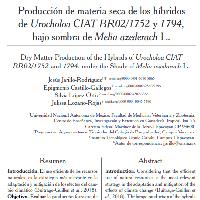Resumen
- Introducción. El uso eficiente de los recursos naturales es la estrategia más relevante en la adaptación y mitigación de los efectos del cambio climático (Buitrago-Guillen et al., 2018). Objetivo. Evaluar la producción forrajera de los híbridos de Urochloa CIAT. BR02/1752 y 1794, a pleno sol y bajo sombra de 1 000 árboles/ha de piocho (Melia azedarach L) al inicio, durante y al final de la época de nortes. Métodos. El experimento se realizó en el municipio de Tlapacoyan, Veracruz, clima semicálido húmedo con lluvias todo el año (1977 mm), suelo andosol lúvico y altitud de 847 msnm. El diseño fue de bloques completos al azar, con base en la pendiente (25%) presente, con mediciones a 4, 8 y 12 semanas de rebrote en dos ciclos (C), C1 del 26/09 al 19/12 de 2020; y C2, del 19/12 al 13/03 de 2021). Resultados y discusión. El ciclo afectó la altura del hijato (P<0.0001). Ambos pastos crecieron igual (P>0.05) en el C1. El C2 estuvo por abajo de C1. La longitud y altura de los hijatos fueron diferentes entre ciclos (P<0.0001). La sombra o el sol no afectaron al número de hojas (P>0.05). En largo de hoja el C1 fue superior (P<0.0001) al C2, y en este último, sol y sombra fueron iguales (P>0.05). En C1, el ancho de hoja de ambos pastos fue similar en sol y sombra y por arriba del C2 (P<0.005). No hubo efecto de bloques, la interacción pasto x edad de rebrote afectó al área foliar (cm2/hijato) en el C1; en el C2, CIAT BR02/1752 mostró menor área. La MS/hijato (3.0±1.4 g/m2) fue similar (P>0.05) entre sol y sombra, así como entre semanas. El rendimiento en sombra fue de 210.4±74.9, 408.1±131.8 y 875.7±380.1 kg/ha a 4, 8 y 12 semanas, respectivamente y bajo sol de 409.5±268.1 1024.4±772.5 y 1151.8±526.8 kg/ha a 4, 8 y 12 semanas, respectivamente. Conclusión. El rendimiento de MS/hijato fue similar en sol y en sombra, pero esta última indujo mayor longitud y altura de hojas e hijatos. A pleno sol, los híbridos produjeron más que en sombra.
- Introduction. Considering that the efficient use of natural resources is the most relevant strategy in the adaptation and mitigation of the effects of climate change (Buitrago-Guillen et al., 2018). The forage production of the hybrids of Urochloa CIAT BR02/1752 and 1794. Objective. Evaluated the forage production of the hybrids of Urochloa CIAT. BR02/1752 and 1794, in full sun and under the shade of 1 000 trees/ha of piocho (Melia azedarach L) at the beginning, during and at the end of the northern season. Methods. The experiment was carried out in the municipality of Tlapacoyan, Veracruz, a semi-warm humid climate with rains all year round (1977 mm), luvic andosol soil and an altitude of 847 meters above sea level. The design was randomized complete blocks, with measurements at 4, 8, and 12 weeks of regrowth in two cycles (C), C1 from 09/26 to 12/19, 2020; and C2, from 12/19 to 03/13, 2021). Results and discussion. The cycle affected the height of the child (P<0.0001). Both grasses grew the same (P>0.05) in C1. C2 was below C1. The length and height of the offspring were different between cycles (P <0.0001). Shade or sun did not affect the number of leaves (P>0.05). In leaf length, C1 was higher (P<0.0001) than C2, and in the latter, sun and shade were equal (P>0.05). In C1, the leaf width of both grasses was similar in sun and shade and above C2 (P<0.005). There was no block effect. The interaction grass x regrowth age affected the leaf area (cm2/tiller) in C1; in C2, CIAT BR02/1752 showed a smaller area. The DM/tiller (3.0±1.4 g / m2) was similar (P>0.05) between sun and shade as well as between weeks. Yield in shade was 210.4±74.9, 408.1±131.8 and 875.7±380.1 kg/ha at 4, 8, and 12 weeks respectively; in full sun of 409.5±268.1 kg/ha; 1024.4±772.5 kg/ha and 1151.8±526.8 kg / ha at 4, 8, and 12 weeks, respectively. Conclusion. The DM/tiller yield was similar in sun and shade, but the latter induced greater length and height of leaves and suckers. In full sun, the hybrids produced more than in shade.
